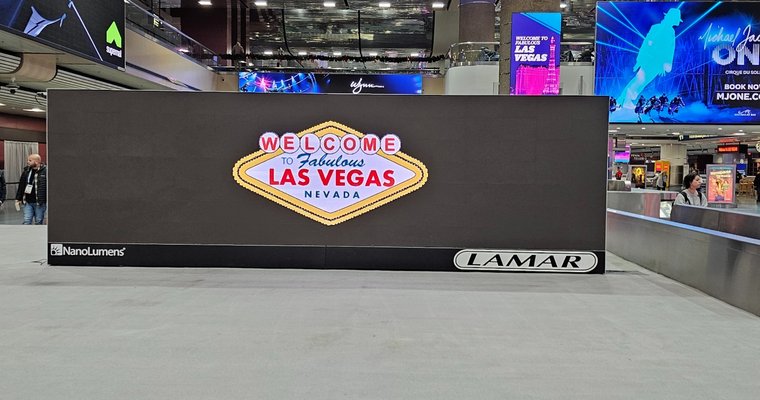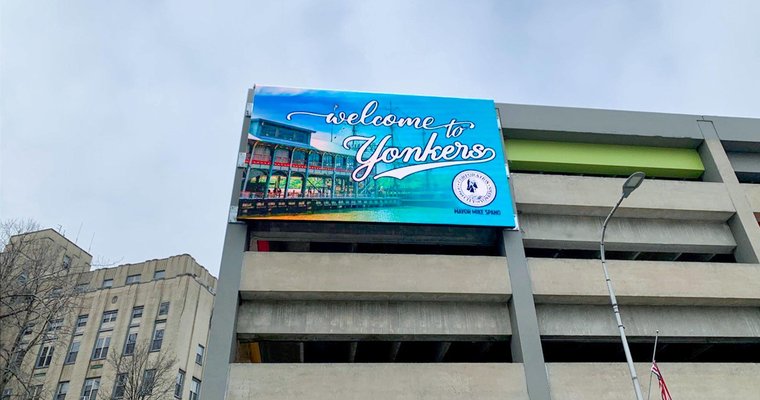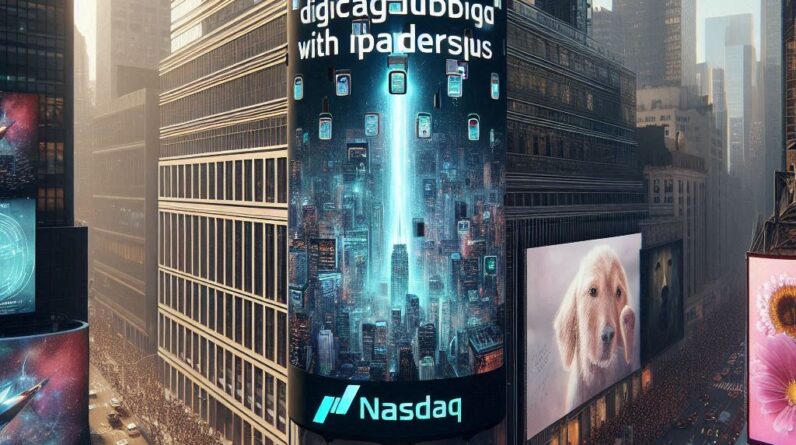
[ad_1]
My first ever Consumer Electronics Show was memorable, both for positive and negative experiences. Along with the power of emerging technologies related to holograms, AI, augmented reality, ePaper, and electric vehicles, I learned wayfinding and self-service experiences can define an entire experience.
My first ever Consumer Electronics Show was memorable, both for positive and negative experiences. Along with the power of emerging technologies related to holograms, AI, augmented reality, ePaper, and electric vehicles, I walked away with a masterclass in why good examples of wayfinding and self-service (or bad ones) can define an entire experience. While I was unable to see every exhibit, I was blown away by the crowds at this year’s show in Las Vegas, and I see a strong year coming for DOOH, smart homes/hybrid workplaces, and more.
My first ever CES began, as all my trips, with the Detroit Metropolitan Airport, which oddly remains a parable for my home industry of digital signage. The main parking garage prices have skyrocketed, along with the profound confusion of trying to navigate them in order to find the rare available spot; it’s almost impossible to tell which way to turn in the labyrinthine structure to go up or down, and one is constantly making wrong turns and generally getting frustrated.
For that reason, I’ve started using alternative parking lots, and while the experience is much less frustrating, I’ll admit that I’m surprised that these parking providers still have not created mobile interactivity and digital signage to help with navigating the lots and saving your parking location; if you lose the paper receipt, you’re at the mercy of your memory when you return from a long trip. The shuttle driver recommended that I take a photo of my parking info for this reason, but I couldn’t help but feel that mobile interaction would add a little polish to the experience.
In the airport itself, I found the classic art exhibits to be a nice juxtaposition with my mission to explore the cutting edge of digital signage and technology at the Consumer Electronics Show in Las Vegas; yet again, I wondered why HD LED wasn’t considered for these exhibits, since art is notoriously fragile and the airport is a very high traffic location where I’d imagine it’s not easy to monitor art to prevent people from touching or otherwise defacing it. The power of holograms in virtual exhibits of art, both in auctions and galleries, using Proto technology has demonstrated that modern tech can protect fragile artworks in a powerful way.
There wasn’t much to say about the plane itself, since I flew Spirit (and will hold the usual jokes). Suffice it to say the only technology in evidence was a QR code on my outbound flight offering to help purchase in-flight Wi-Fi (which, ironically, was completely unavailable on my returning flight because the plane was only a few months old and hadn’t yet had it installed).
The Harry Reid airport had an incredible abundance of digital signage, with impressive creative. I was pleased to see anti-trafficking messages, since the scourge of human trafficking remains, though it’s tragic that such efforts are so necessary. The messages included QR codes for mobile interactivity, and I hope they are helping. There were also countless examples of self-service kiosks and technology, from the Kylie makeup kiosks selling Kardashian wares to a board from Lamar in the classic Vegas style welcoming travelers to the city. I was also pleased to find many of the cab services had self-service kiosks for passengers, allowing for easy payment, along with transparency of rates. I’ve slowly started using traditional cabs instead of solely using Lyft and Uber, and there were several cases where I felt I was saving money with a traditional taxi over what I would have spent using rideshare services.
 |
 |
 |
Photos: Daniel Brown/Networld Media Group. |
CES at The Venetian
After checking into the downtown Grand, where I consistently got lost, thanks to lack of wayfinding digital signage, as you can see from the below video of the maze-like halls, my first stop was the Venetian, site of a major breakout-wing of CES.
Interestingly, while the hotel itself blended classic décor with impressive self-service wayfinding digital signage, the event’s digital check-in systems were down, leading to some confusion in finding the right line to pick up my badge (no automation this time).
Unfortunately, I did have trouble then finding my way to the actual event venue, getting turned around in the large casino area of the hotel and going to the wrong floor before a hotel staff member helped me find my way. For an event devoted to technology, I was disappointed in the lack of digital signage for wayfinding, and the app was not super helpful either. Other events I’ve covered have apps which show your location along with the correct path to your goal; I did not find the CES app to be at all helpful, since it seemed only to show a diagram of a given floor of the event, without directions. I was also surprised that the wayfinding installations weren’t digital; they were simply analog maps, which were hard to decipher due to the sheer size of the event.
Indeed, that became a theme. There were so many people that even in the largest venues (from the Venetian to the Las Vegas Convention Center) you sometimes couldn’t even move without jostling and being jostled, adding to the wayfinding stress. Additionally, there were some large exhibits where I had standing appointments, but there were so many sub-teams of a given company that nobody at the various help stations knew how to find the people I had set up meetings with.
Yet again, the lack of self-service and an integrated software system stood out; it would be so much easier for press (and customers, for that matter) if vendors had a system that integrated with the CES app, calendaring, and contact information such that you can easily be navigated to your appointments or desired booths (and can easily call or email representatives of a given company). For the “show of the future,” this shouldn’t be a stretch. It’s theoretically possible that the app had some functionality I was missing, but if so, it should have been much easier to access.
 |
 |
 |
 |
Images: Daniel Brown/Networld Media Group. |
The sheer size of the event, as readers will know, made it impossible to visit every booth. I made a quick pass through the international section, which featured everyone from the U.S. to France, Italy, South Korea (billed simply as Korea), the Netherlands, and more. The U.S. exhibit highlighted the problem of IP theft at home and abroad, with various real-world examples of product piracy.
I had the privilege of speaking to Anton Dembitsky, CEO and co-founder at InVisionaryBox, a tech firm based in Ukraine, in a conversation highlighting the power of innovation despite the war at home. Wearing a traditional Ukrainian Vyshyvanka, Dembitsky demonstrated the augmented reality tools developed to create customer engagement and brand awareness, including AI-powered gamification software. In fact, I had first heard of the firm through a press release on the AI-powered software, which was developed with psychologists and found to aid in rehabilitation for traumatized children.
“What we’re doing is we’re creating the augmented reality engagement experiences for the visitors of a shop,” Dembitsky said, showing one game where the visitor’s head is replaced in the mirror display by a virtual bee; by moving your head up and down, you can dodge hazards, collect tokens, and win points that later can be redeemed for prizes or goods from the physical shop.
A conversation with Raffi Kryszek on the present and future of holograms. Video: Daniel Brown/Networld Media Group. |
It was another reminder that, despite all the work that has gone into wearables for VR, humans seem to enjoy virtual reality or augmented reality experiences that happen without wearables, something strongly emphasized by various AR and VR innovators in my conversations over the past couple of years, including my chats with Shawn Frayne of LookingGlass along with David Nussbaum and Raffi Kryszek of Proto.
I spotted eye-catching hologram technology at the Netherlands stand, though I didn’t find the full-height human display to be quite as eye-catching as some of the American examples I’ve seen from firms like Proto or Looking Glass. Still, it was illuminating to see just how many international firms are working on technologies that I previously considered the domain of one or two American firms; from holograms and 3D anamorphic displays to wireless power and electric vehicles, it was astonishing to see how many businesses are tackling issues that I have predicted in my writing to be major themes of the future.
Incidentally, I was intrigued by how many examples of laser projection I spotted along the way. I tend to feel that a mix of LED, OLED, and ePaper is the most effective strategy when navigating low-medium-high brightness presentation of your creative; however, I have seen strong examples of projection in the past (like the casino in Florida we covered last year), so I can’t fully write it off, especially as recent improvements like color fidelity and resolution have been rolled out by providers. I’m not particularly bullish about laser, but I’ll keep my eyes open in the coming year for further innovation.
 |
 |
 |
 |
Photos: Daniel Brown/Networld Media Group. |
I must pause to reiterate the sheer quantity and quality of high resolution digital signage throughout the Venetian. In a town of flashing lights, I was blown away by the care and attention to detail in each display, whether it was the lobby DOOH displays or the ones above hotel amenities like movie theaters, restaurants, or clubs.
In fact, as a Vegas newbie, I was taken aback that the gambling machines themselves, with few if any exceptions, were fully digitized. Far from the “one armed bandit” of yore, with mechanized components, the entire experience is one of digital signage — with the most powerful example, obviously, being the strip itself, where the sky has been replaced by LED (see below for striking examples).
As predicted in previous travels, virtual production is a major theme in digital signage. We’ve previously covered ways virtual production and metaverse elements are changing live entertainment and moviemaking, and there were powerful examples of the ways virtual production is making broadcast, film, and event production easier, faster, and cheaper. I made special note of the Sony presentation of the expanding world of virtual production for film and television.
 |
 |
 |
 |
Image: Daniel Brown/Networld Media Group. |
Electric vehicles and EV charging stations
We’ve covered the rise of EV’s in some depth, along with the rise of DOOH advertising at EV charging stations, so I was interested by the large number of vendors presenting electric vehicles, electric vehicle charging tech, and “smart”-car technology (such as integrated radars). Examples, including Sony and Kia, are below; note the power of analog in the Kia centerpiece, which juxtaposes with the futurism of the electric vehicle exhibit (instructive for digital signage pros and business marketers alike).
While attention often goes to sedans and SUVs (or, thanks to the Tesla Cybertruck and Rivian, trucks), two-wheel transportation is also going electric in a big way, with operators like Zapp and Volta making heavy investments in electric motorcycles. I was privileged to stop by the Volta booth for a 1:1 conversation with
I was privileged to sit down for a long, exclusive chat with Mike Battaglia, COO at Blink Charging, about the present and future state of the electric vehicle industry, including questions about regulations, potential risks and rewards of the technology, and the power of charging stations as digital out-of-home advertising hubs (along with other forms of infotainment content).
I asked Battaglia for his big takeaway message for 2024. “Have confidence. If you’re considering an electric vehicle, if you’re on the fence, have confidence that you are going to be able to charge. Because, as I mentioned, we are installing chargers every single day, coast to coast, the network is growing at an incredibly robust rate.
“You know, this isn’t a financial kind of discussion, but here’s a case in point. Our third quarter of 2023, our revenue was up 152% year over year. We had a record year for Blink. We anticipate that 2024 will surpass 2023. So, this is happening.”
While admitting that consumers might be worried about charge networks in light of negative news coverage from outlets like the New York Times about challenges facing the industry, Battaglia said the top priority for his team is not only growing the charging network, but fixing and preventing issues like broken or dysfunctional chargers.
Audiovisual hardware
I worry that in covering digital signage, we sometimes forget the A in Pro-AV, so I was pleased to see various sound operators, including Gemeni waterproof mobile speakers. Across tech verticals, we are seeing a “flattening” in which the various parts of our lives (from work and play to travel) start commingling, and we are carrying our work and play to new locations and in all weather.
For that reason, having strong protection from dust, water, and other environmental stress is ever more important, whether you’re opening a bar and grill with an outdoor patio, presenting a live concert, or simply going on an outdoor adventure with friends. The floating, waterproof speaker installation was striking, and I couldn’t help wondering about versions of the tech at scale for large events and concerts.
Due to the sheer crowds, I wasn’t able to get inside the Google tent in a timely way, giving up midway through the lines, but I did appreciate their spirited use of digital signage to promote their Android and other exhibits.
Other large vendors, such as Amazon, leaned heavily into familiar themes from the smart home and smart workplace revolution, including Amazon Alexa-integrated devices, such as the Amazon Echo speakers (with new models on the horizon). And, as always, drones and robotics demanded center stage in several exhibits; note that smart and autonomous vehicles, along with drones and robotics, continue expanding across industries and even agricultural applications.
Sustainability and ePaper, eInk
Readers know my passion for sustainability, which is top of mind for customers and businesses alike in digital signage and proAV, so I was privileged to sit down with Timothy O’Malley, AVP US RBU at E Ink Corporation, to discuss the ways eInk and ePaper are transforming digital signage, advertising, and more.
In our wide-ranging conversation, I learned that eInk has spread far from e-readers and now features robust, full-color displays (including menu boards and DOOH screens), tablets like the ReMarkable and the Kindle Scribe, and even guitars that can change their surface decoration in real time, along with computer and laptop screens designed to reduce blue light hazard to users who have to use screens for long stretches. With a massive reduction in paper- and ink-based waste across various industries, the tech can be used in restaurants, hospitality, and transportation (we covered the adoption of eInk by Qatar in the recent FIFA event). I was perhaps most intrigued to hear about the use of eInk not only to make color-changing cars (yes, really) but even fashion (clothing that, like a chameleon’s skin, changes in real time) and potential research into other use cases, such as eInk tattoos.
I was again struck by something unique to my work in the digital signage industry; so many of the innovators working around sustainability in particular demonstrate an outspoken passion to make technology sustainable.
I was also struck by the way that “coopetition,” the ecosystem in which even competitors often act as collaborators, defines not just examples of ePaper but digital displays in general. Because ePaper relies on ambient light, there will always be a place for traditional LED signage, but I’m excited to see how far the tech has come in replacing many use cases where LED is not needed; the power savings and attendant budget savings can be strong tools in business ROI, on top of the sustainability benefits.
I just had time to stop in at the LG booth for a full tour, and was struck not only by the transparent LED displays but the sustainability efforts, including a combination clothes washer and dryer.
 |
 |
Images: Daniel Brown/Networld Media Group. |
The sheer size of the event and the quantity of people was overwhelming, and on Wednesday alone my fitness tracker had me at 10.5 miles of walking, but it was worth it to get a feeling for the zeitgeist in my industry and peripheral ones. Automation and self service, digital signage, and electric vehicles are growing at a breakneck pace; it was a fitting reminder, as I checked out of my hotel, that the exit featured the self-service bike rental machines and kiosk outside; an irony intensified by the sheer number of steps I put in across the event venues. The future is bright for proAV and digital signage, but only so long as businesses and events remember that an emerging technology is only as good as your content and the way you deploy it for users; my hope is that large events like CES refine their approach to wayfinding (and related accessibility issues), and I hope that large hospitality venues take a page from the Venetian’s book and invest heavily in digital signage and wayfinding.
 |
 |
 |
Images: Daniel Brown/Networld Media Group. |
Daniel Brown is the editor of Digital Signage Today, a contributing editor for Automation & Self-Service, and an accomplished writer and multimedia content producer with extensive experience covering technology and business. His work has appeared in a range of business and technology publications, including interviews with eminent business leaders, inventors and technologists. He has written extensively on AI and the integration of technology and business strategy with empathy and the human touch. Brown is the author of two novels and a podcaster. His previous experience includes IT work at an Ivy League research institution, education and business consulting, and retail sales and management.
[ad_2]
Source link






